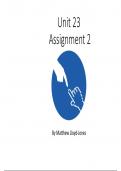Summary
Summary Unit 23 Assignment 2 - The fundamental principles of HCI and interface design (Free additional notes on uploads)
- Institution
- PEARSON (PEARSON)
Task 1 - The fundamental principles of HCI and interface design Task 2 - How HCI can be adjusted to suit specialist needs
[Show more]



